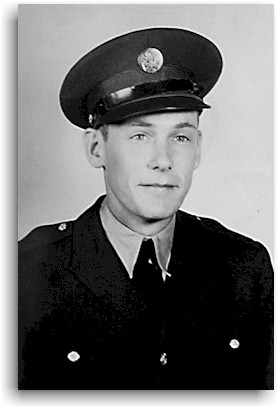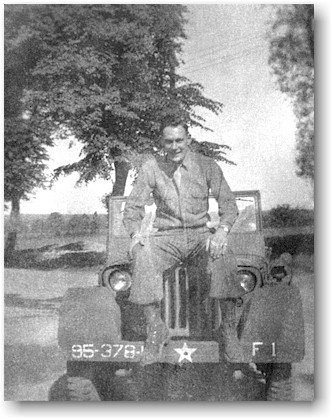|
Edward D. Snell |
 |
 |
| Company
"F", 378th Infantry Regiment |
 I am one of the original members of the 95th Infantry Division. In July 1942, I began basic training at Camp Swift, Texas. Seventeen weeks later, we were sent to Fort Sam Houston in San Antonio. I began maneuvers in Louisiana in June 1943, and by October moved to Camp Coxcomb, California for desert maneuvers. A troop train transported us across the country to Indiantown Gap, Pennsylvania. I then trained for mountain maneuvers in West Virginia and had 50-caliber machine gun practice in North Carolina. I sailed from Camp Miles Standish aboard the U.S.S. Mariposa on August 6, 1944 and arrived in Liverpool, England August 15. We were then transported by rail and trucks to Winchester, England, where we assembled our trucks, jeep, tanks and other equipment before crossing the channel.
I am one of the original members of the 95th Infantry Division. In July 1942, I began basic training at Camp Swift, Texas. Seventeen weeks later, we were sent to Fort Sam Houston in San Antonio. I began maneuvers in Louisiana in June 1943, and by October moved to Camp Coxcomb, California for desert maneuvers. A troop train transported us across the country to Indiantown Gap, Pennsylvania. I then trained for mountain maneuvers in West Virginia and had 50-caliber machine gun practice in North Carolina. I sailed from Camp Miles Standish aboard the U.S.S. Mariposa on August 6, 1944 and arrived in Liverpool, England August 15. We were then transported by rail and trucks to Winchester, England, where we assembled our trucks, jeep, tanks and other equipment before crossing the channel.
I landed on Omaha Beach September 14, 1944, and made camp in an apple orchard a short distance from the beach. Immediately, drivers were needed for the Red Ball Highway. I drove the Red Ball Highway until October 5, 1944. By October 20, I was on the front line south of Metz.
The 2nd Battalion, 378th Infantry Regiment, Co. F encountered fierce fighting around the bridgehead at Thionville, Fort Yutz, Basse-Yutz and Fort d'Illange, France between November 10-15. The 2nd Battalion, 378th Infantry Regiment, Co. F received the Presidential Unit Citation for taking and securing the bridgehead at Thionville.
While engaged in the fighting around Fort d'Illange, I lost my best friend, Leo Merrigan, to an 88mm shelling. I was hit in the back of my arm by a piece of shrapnel and received my Purple Heart. I went on to see more action in the Saarlautern area and the Siegfried Line near Lisdorf and Ensdorf.
During the night of December 4, 1944, I backed my Jeep and trailer loaded with mortar packs, ammunition, K-rations, and C-rations into a barn in Lisdorf overlooking a graveyard and the Saar River. Our company was preparing to make an assault across the river into Ensdorf early on December 5. In early morning hours of December 5, men filed by and the mortar packs, ammunition, K-rations, and C-rations were handed out as they headed out of the barn and down though the graveyard towards the river. After the men had left for the river, I was rearranging the mortar packs and ammunition when an 88mm shell hit just across the street. Knowing that after each round was fired, the next round would land just a little further out, I jumped through a side door just as the next round came though the two large barn doors. The round hit the front of the jeep and sliced through the front differential, flattened all of the tires and shredded the mortar packs in the trailer. The concussion knocked me down as well as the cow that was in her stanchion. She was bellowing, and I thought for sure I was hit. Dirt and dust was so thick I couldn't see anything for a while. The jeep was just squatting on its axels with my can of Pet Milk running out of the glove box; what a mess. The round hit the front of the jeep and sliced through the front differential, flattened all of the tires and shredded the mortar packs in the trailer. The concussion knocked me down as well as the cow that was in her stanchion. She was bellowing, and I thought for sure I was hit. Dirt and dust was so thick I couldn't see anything for a while. The jeep was just squatting on its axels with my can of Pet Milk running out of the glove box; what a mess.
By the end of January 1945, the 95th was transferred to the 9th Army and was ready to make the push into the Ruhr Pocket and take the towns of Dortmund, Munster, and Hamm. When the war ended, I was in Bremen, Germany guarding submarine assembly docks, which had been heavily damaged by Allied bombing. Soon we took all of our trucks, Jeeps, tanks, and equipment back to Camp Lucky Strike in LeHavre, France and left them there. We returned to the U.S on the U.S.S. Mariposa, the same ship that had brought me to Europe. I was discharged at Fort Sill, Oklahoma October 24, 1945, after three years, three months, and three days in the U.S.
Army.
On
the left : Edward D. Snell on his jeep.
I want to
thank Michael Flora,
son-in-law of Edward D. Snell for the use of the photographs and
documents.
|

